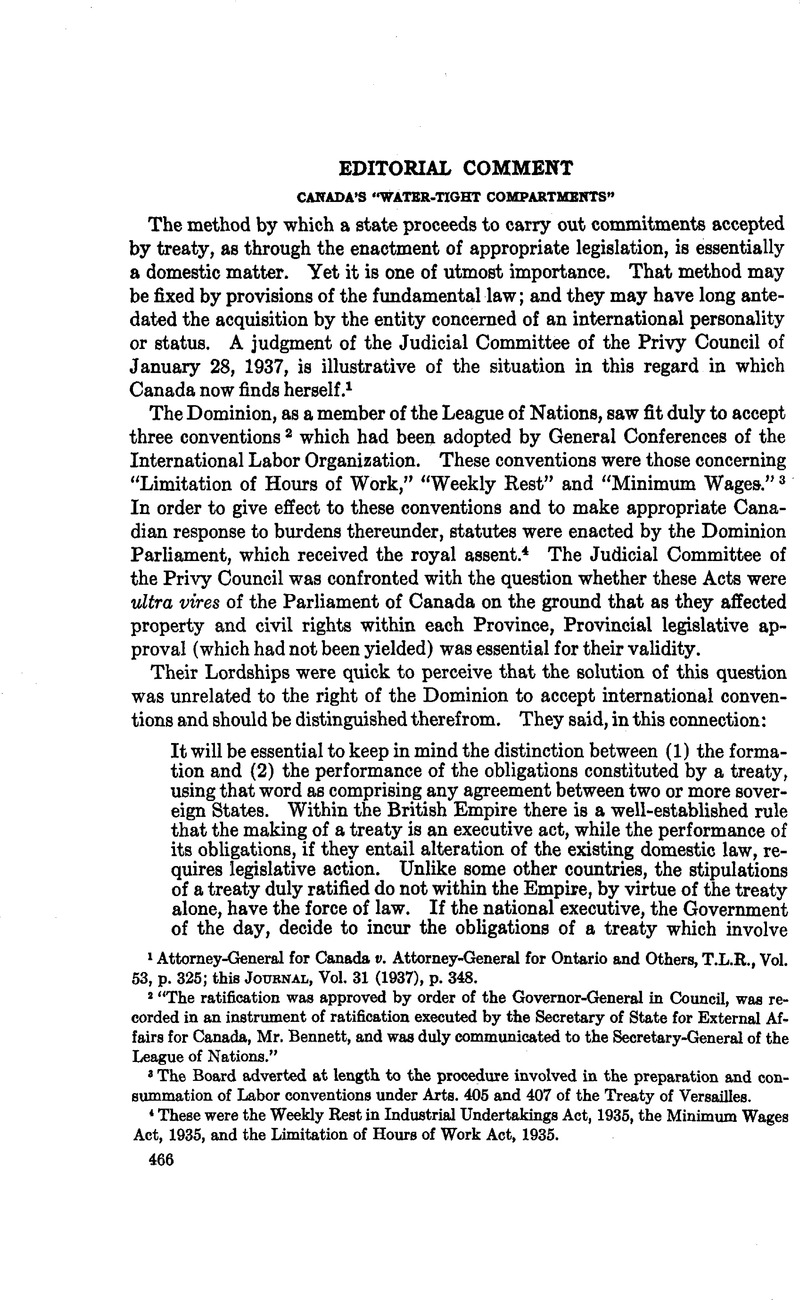Published online by Cambridge University Press: 12 April 2017

1 Attorney-General for Canada v. Attorney-General for Ontario and Others, T.L.R., Vol. 53, p. 325; this JOURNAL, Vol. 31 (1937), p. 348.
2 “The ratification was approved by order of the Governor-General in Council, was recorded in an instrument of ratification executed by the Secretary of State for External Affairs for Canada, Bennett Mr., and was duly communicated to the Secretary-General of the League of Nations.”
3 The Board adverted at length to the procedure involved in the preparation and consummation of Labor conventions under Arts. 405 and 407 of the Treaty of Versailles.
4 These were the Weekly Rest in Industrial Undertakings Act, 1935, the Minimum Wages Act, 1935, and the Limitation of Hours of Work Act, 1935.
5 They added: “Parliament, no doubt, as the Chief Justice pointed out, has a constitutional control over the executive, but it cannot be disputed that the creation of the obligations undertaken in treaties and the assent to their form and quality are the function of the executive alone. Once they are created, while they bind the State as against the other contracting parties, Parliament may refuse to perform them and so leave the State in default.”
6 For the text thereof, see this JOURNAL, Vol. 4 (1910), pp. 39–67.
7 The Board said that it had to be admitted that, normally, the legislation here involved came within the classes of subjects assigned by Sec. 92 exclusively to the legislatures of the Provinces—namely, property and civil rights in the Province; and that it was not within the enumerated classes of subjects in Sec. 91, and appeared to be expressly excluded from the general powers given by the first words of that Section.
8 This JOURNAL, Vol. 31 (1937), p. 356.
9 This JOURNAL, Vol. 31 (1937), p. 357.
10 Declared Mr. Charles E. Hughes in an address before the Union League Club of New York, March 26, 1919, on the proposed Covenant for a League of Nations: “There is nothing in our history to give assurance that Congress would recognize the authority of the treaty power to bind Congress to declare war in a cause that it did not approve. The decision as to the policy, as to the existence of the duty, and as to the power to create the duty, would rest with Congress. Whether or not Congress would feel itself bound to respond, or would take the position that, in so vital a matter as a resort to war, it could not be pledged in advance without its consent, is a question which must be left to the event⃜
“The point is that Congress would be the judge of its obligation and would determine to its own satisfaction the question whether the treaty power could impose and had imposed upon Congress the duty to act under the provision of the Covenant, although Congress believed that such action would be contrary to the interests of the country⃜
“It is a very serious matter for the treaty-making power to enter into an engagement calling for action by Congress unless there is every reason to believe that Congress will act accordingly.” (Quoted in Hyde, International Law, II, 24, footnote 1.)